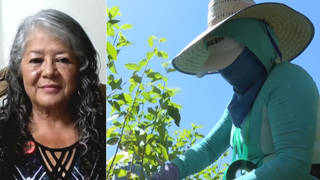
Guests
- Nora Fermprogram director at International Labor Rights Fund, co-author of “A Valentine’s Day Report: Worker Justice and Basic Rights on Flower Plantations in Colombia and Ecuador.”
- Beatriz Fuentespresident of Sintrasplendor union in Colombia. She has worked nine years in Colombian rose plantations and is in the U.S. to publicize the issues facing women workers in Colombia’s flower industry.
Today is Valentine’s Day. Chocolate, flowers, diamonds. How can gifts that bring so much happiness have come from so much pain? We begin our coverage with a look at the flower industry. Nora Ferm of the International Labor Rights Fund talks about a new report on labor conditions at U.S.-owned flower plantations in Colombia and Ecuador. We’re also joined by Beatriz Fuentes, president of the Sintrasplendor Union at Dole’s largest flower plantation in Colombia which has become the site of a growing workers’ struggle. [includes rush transcript]
Transcript
AMY GOODMAN: Yes, today is Valentine’s Day. Chocolate, flowers, maybe even diamonds. How can gifts that bring so much happiness come from so much pain? Those lovely flowers you may get, they could have been genetically engineered, grown in Colombia on a giant pesticide-soaked factory farm run by the U.S.-owned Dole Foods. Or how about those chocolates? Well, over 40 percent of the world’s cocoa comes from the Ivory Coast, in West Africa, where child labor and child slavery is widespread. And the diamonds? Well, a girl’s best friend? Well, they may have been used to finance some of the most brutal warfare of the last two decades. Valentine’s Day, what’s not to like? Well, our guests today will give you all the unlovely details.
We’ll start by looking at the flower industry. Why should U.S. consumers care where your flowers come from? Well, according to a new report, approximately 60 percent of all flowers sold in the United States come from Colombia. A third of Ecuador’s yearly production is exported to the United States for Valentine’s Day. Flower workers in these countries earn poverty-level wages, work long hours, suffer significant health problems due to pesticides. The report also finds over half of women workers in the flower industry in Colombia and Ecuador have been subjected to sexual harassment. Dole is the largest exporter of flowers in Latin America. Its largest flower plantation in Colombia is currently the site of a growing workers’ struggle. Over the weekend, Dole fired almost 200 flower workers from the plantation.
Nora Ferm is program director at the International Labor Rights Fund in Washington, co-author of the report, “A Valentine’s Day Report.” She joins us from Washington. And with Nora is Beatriz Fuentes, president of the Sintrasplendor union, which is located at Dole’s largest flower plantation in Colombia. We welcome you both to Democracy Now! Nora, I would like to begin with you. And also, thank you very much for offering to translate for Beatriz. Lay out the report, your Valentine’s Day report.
NORA FERM: Well, this report focuses on the key labor rights violations that occur at most Colombian and Ecuadorean flower plantations. It has a special focus on Colombia, but we also look closely at Ecuador. We look at wages, occupational health and safety issues, sexual harassment and discrimination issues that face women workers. And we have four case studies that look at obstacles to organizing in the cut flower industry. The plantation that Betty works at is one of the key case studies, and we also have two from Ecuador and one additional one from Colombia.
AMY GOODMAN: And explain exactly what’s happening in each of these places.
NORA FERM: There are two flower plantations in Ecuador that have tried to organize unions. When workers try to organize unions, they are generally subject to severe retaliation on the part of the companies. There was one company called Rosas del Ecuador, where the workers went several months without being paid their salary. They went on strike. They had to be on strike for more than two years. They weren’t allowed to leave the plantation. If they had left the plantation, they would have been accused of abandoning the workplace and would not have been able to receive any of the back pay that they were owed. So they stayed in shifts on the plantation, growing lettuce and other vegetables to allow themselves to survive and filing legal complaints with the Ministry of Labor.
Finally, this past year, they received a resolution saying that they were in the right and the employer had to pay these wages. The employer had since disappeared. And so, the workers were left with this land. Unfortunately, during all of this time, because the workers themselves don’t have access to the exporters or the retailers, they weren’t able to continue the plantation functioning and continue exporting. So the greenhouses have fallen down, the plants have all died, and the workers are left with a totally dysfunctional plantation, which doesn’t really serve to compensate them for the thousands of dollars in back pay that they were owed.
This is one example of how workers are unable to organize, and all of the surrounding plantations tell their workers, “This is an example of what will happen if you do try to organize.” So they use this to create an environment of fear to prevent similar attempts to organize at other plantations. Beatriz will be able to talk to you a little bit more about what happens at the Dole plantation, and we have a couple other case studies in there.
AMY GOODMAN: Well, let’s turn to Beatriz Fuentes, again, president of the union in Colombia, has worked for years in Colombian rose plantations in the U.S. to publicize the issues facing women workers and Colombia’s flower industry. Beatriz, describe where you work.
BEATRIZ FUENTES: [translated] This is the area that surrounds the city of Bogota in Colombia. It’s a flat valley covered with greenhouses, plastic greenhouses, where roses are grown.
AMY GOODMAN: And how many people work there? How are the flowers grown? What happens to you?
BEATRIZ FUENTES: [translated] There are 90,000 workers in the Colombian flower industry, and 65 percent of them are women. Most of them are single mothers. At my particular plantation, there used to be 1,600 workers, but due to the closure of the factory and the plantation, which Dole authorized last October 12th, we’re now only 150 workers. The process of growing a flower involves planting the rose plant, weeding, making sure there are no illnesses, harvesting, classifying and packing the flowers. But during this whole process, we encounter a lot of problems.
AMY GOODMAN: What kinds of problems?
BEATRIZ FUENTES: [translated] We have very low wages. We suffer occupational health illnesses. We are not allowed to organize unions. There is increasing use of subcontracting and short-term contracts. And we are subject to serious cases of discrimination.
AMY GOODMAN: What does it mean to unionize, and how has the plant responded to the Sintrasplendor union, the one that you head?
BEATRIZ FUENTES: [translated] We formed the union in November 2004, and there was constant aggression and constant retaliation against our union. We weren’t even allowed to share information with the workers. For the company, when we gave out brochures about why we had formed a union and what it was all about, they saw that as declaring war.
AMY GOODMAN: So what are you doing now?
BEATRIZ FUENTES: [translated] We’re trying to create pressure so that workers who are fired from the Dole plantation are adequately compensated and that Dole follows all of the legal processes in Colombia during this process. We’re also trying to create pressure so that Dole does not close other plantations that it has in Colombia, particularly one that has also an independent union called La Fragancia.
AMY GOODMAN: For people in this country to understand just your daily work, what do you do in the factory, in the plant?
BEATRIZ FUENTES: [translated] I wake up at 3:00 a.m. every day to give me time to get my children up and dressed. The bus is waiting for me at 5:00, and I get to work at 6:00 a.m. In the morning hours, we are supposed to cut the roses that will be shipped that day. We are subject to extreme pressure to cut a certain number of roses every hour, and if we don’t comply with this they start filing reports with the management about how we’re not doing our job well. Then we go to the classification room, where we classify the roses based on their color, and we make sure that they don’t have any marks or illnesses. We make sure that the size is right of the flower and of the stem, and we package them in certain quantities of about 25, sometimes 10, depending on what the clients are asking for. Then we put them all in boxes, and we put the labels on them, and we send them off. Most of these flowers will go to the United States, but some of them are also sent to Europe.
AMY GOODMAN: I want to say that we did call the Dole Company. They didn’t get back to us. But what do you want people, Beatriz, here in the United States to know today on Valentine’s Day?
BEATRIZ FUENTES: [translated] We want them to enjoy the flowers that they are receiving today, but we also want them to think about what’s behind these flowers. There are low wages, there’s discrimination, there are other things that are behind the flower that you hold in your hands.
AMY GOODMAN: Nora Ferm, I think it would also surprise many people to know that a third of Ecuador’s yearly production of flowers actually is exported to the United States just for this day, for Valentine’s Day. The situation in Ecuador that you are calling for a change in, Nora?
NORA FERM: Well, I think it’s important to look at how workers are treated, particularly in this time leading up to Valentine’s Day. Workers are working sometimes 20-hour days to get this production ready to go for this particular holiday, and special workers are hired just for this season, just for a few weeks before Valentine’s Day, and then they’re left without a job. So I think, you know, in Ecuador there’s a need to look at how the contracts are used, the use of subcontractors, and to think about how to make sure that these workers have stable employment and make sure that they’re just not left out in the street after Valentine’s Day passes.
AMY GOODMAN: And what role do you think people in this country can play?
NORA FERM: I think it’s very important for everyone to try to talk to the retailers, talk to the florists where they’re buying the flowers, ask them to try and find out what working conditions are like at the supplying plantations, try to ensure that those plantations don’t have any of the problems that Beatriz has already mentioned. I think that if consumers can show a more active interest in purchasing flowers made under good working conditions, then florists and the suppliers themselves are going to go to more of an effort to ensure that those conditions exist. That may be through a certification program, or it may not be, but we need consumer demand in order to make changes on the ground happen.
AMY GOODMAN: Well, Nora Ferm and Beatriz Fuentes, I want to thank you both for being with us. The report prepared by the U.S./Labor Education in the Americas Project, International Labor Rights Fund is called “A Valentine’s Day Report: Worker Justice and Basic Rights on Flower Plantations in Colombia and Ecuador.” And we will link to it at our website at democracynow.org.












Media Options